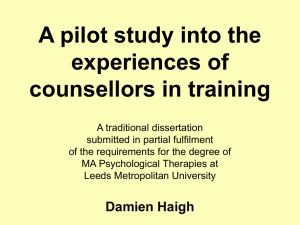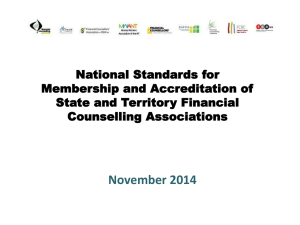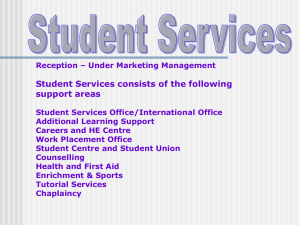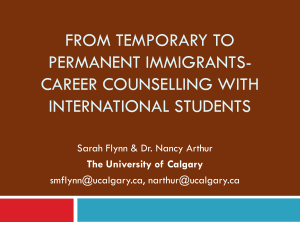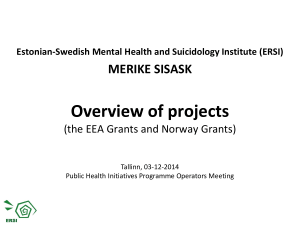1. An overview of KHL email counselling
advertisement
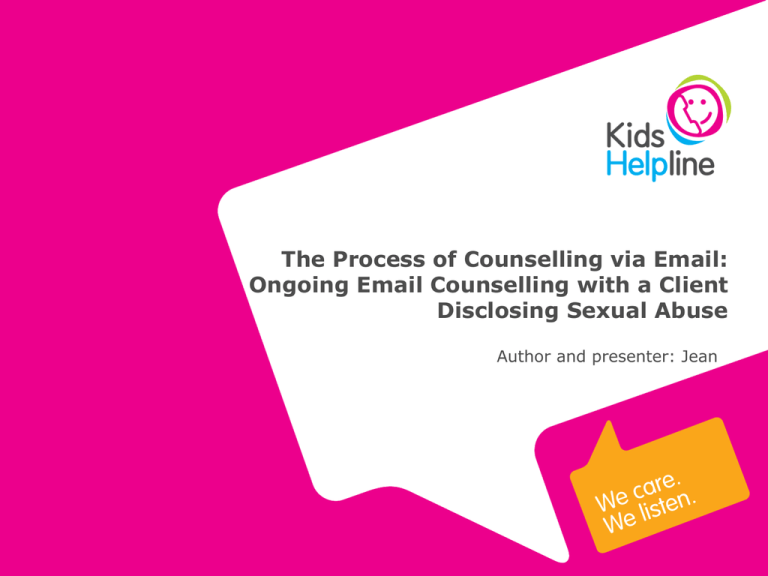
The Process of Counselling via Email: Ongoing Email Counselling with a Client Disclosing Sexual Abuse Author and presenter: Jean Topic: Kids Help Line counselling process and procedures for Email: Ongoing email counselling with a client disclosing sexual abuse. This discussion will be in three parts 1. An overview of KHL email counselling 2. Strengths and limitations of e-mail counselling including the use of literary techniques to increase clarity of communication 3. A Case Study of ongoing e-mail counselling including the application of Duty of Care principles 2 1. An overview of KHL email counselling Kids Helpline is the only free, confidential and anonymous national telephone and email and web counselling service for young people aged 5 to 25 years. It is free, anonymous and confidential. Kids Helpline began e-mail counselling in 1999 and web counselling in 2000.The move towards providing on-line counselling services was driven by: •Responding to the young people who requested online options for seeking help •Our BoysTown values of being innovate and resourceful and using the latest technology to meet the urgent needs of young people. 3 2. Strengths and limitations of e-mail counselling includes the use of literary techniques to increase clarity of communication Advantages of on-line counselling includes reaching a wide audience, integration of delivery with existing services and improved access – particularly for certain disadvantaged groups including those who are socially isolated. The Kids Helpline website provides young people with access to counsellors via web-counselling and e-mail. It also has information on a variety of subjects relevant to young people (e.g. mental health, homelessness, bullying) and has a data base of other helping services around Australia. 4 Overview of KHL Online Counselling 2007 During 2007 Kids Helpline counsellors engaged in 53,168 counselling session: 40,890 telephone and 12,278 web and e-mail sessions. While less contacts are made on-line than by telephone, the issues discussed online are more complex and severe than those dealt with on the telephone. General feedback from young people indicates that online counselling enables them to feel safer, more anonymous and more in control of their emotions and find sensitive, difficult and deeply personal issues easier to write about than talk about. (Kids Help Line Case Study: Delivering services and support) 5 Increase in ongoing counselling and intensive support Ongoing counselling was provided at almost double the rate though our online services (21%) compared with telephone counselling (11% 6 Age, gender and background of clients Online clients tend to be older, with 15-25 yr-olds involved in threequarters of online counselling sessions (compared with two-thirds of telephone sessions). Boys and young men continue to prefer contacting by telephone (compared with one in ten via the on-line service). Kids Helpline provides strong support to children and young people living in regional and remote areas. These young people tend to have less access and choice in support services. E-mail contacts increased by 71% in 2007 with the service receiving 941 e-mail contacts from rural and remote area compared with 550 in 2006. 7 Concerns of Australian children and young people Main concerns – highlights and trends: Online vs. telephone counselling During 2007, online counselling continued to be accessed for different concerns to telephone counselling. In the eight years KHL has offered web and e-mail counselling, greater proportions of young people have consistently sought help online for some of the more severe concerns. Deliberate self injury, emotional and/or behavioural management, mental health issues, self-image, and eating and weight issues were presented online at almost double the rate of telephone counselling during 2007. Conversely, more children and young people were likely to engage in telephone counselling rather than ongoing services when needing to discuss concerns surrounding drugs and alcohol, bullying, pregnancy and homelessness. The top 15 concerns about which young people contacted KHL online are shown in here (*INSERT FIGURE 3: MAIN ONLINE PROBLEM TYPES 2007 FROM 2007 REPORT) Telephone counselling figures are also given in order to provide a comparison. 8 Emotional/behavioural management This was the top concern for online counselling, frequently with an ongoing client and the young person was also often engaging in selfinjury. The proportion of contacts about emotional and/or behavioural management concerns via online (18%) was substantially higher than via the telephone (10%) Mental Health issues Mental Health issues Mental health concerns were the second most common online counselling concern. Mental health concerns were presented in proportionally higher rates online (15%) compared with telephone (8%). 9 Suicidality A higher proportion of suicide concerns were presented via online counselling (4.1%) than on the phone (2.8% of calls). The proportion of young people with current thoughts of suicide presenting for online counselling (8% of sessions) was more than the rate of the telephone service (6% of calls) (* above information cited from Kids Helpline 2007 report) 10 Procedures for KHL e-mail KHL Shift Supervisors read all e-mails to the service and allocate a priority to them according to urgency i.e., whether they need to be replied to immediately or within 24 hrs, within 3 day, within 5-7 days. In cases of Duty of Care callers are asked to telephone Kids Helpline if they need immediate help and are sometimes given a time frame by which they need to contact us by to ensure their safety. When clients have not replied and there is concern for their safety or it is assessed therapeutically useful, counsellor can send an ‘outreach’ email to client to check on their safety and/or encourage them to reengage with the service. Clients are able to request to speak to a male or female counsellor and to speak to the same counsellor on an ongoing basis. 11 Issues in delivering online counselling: strengths and limitations Issues of privacy and confidentiality KHL provides information on the KHL web site which users need to read before reaching the e-mail address. Issues of confidentiality, information keeping and security are outlined. Client’s then read the following information to allow them to decide which mode of counselling e-mail, web or phone best meets their needs at the present moment:“Some times an email response can take up to 2 weeks. How long depends on how many young people have written to us all at the same time. If you need to talk to someone straight away it is quicker to ring us on 1800 55 1800.” 12 Increased flexibility and accessibility for many clients Strength Clients can send an e-mail to KHL at anytime so they can write about their feelings as they feel them (for instance in the middle of night when in crisis). When the counsellor replies s/he can invite the caller to reflect upon what was happening for them at the time. This has an advantage over face to face counselling where, by the time the client comes to their next face to face session, they may have forgotten or may downplay the intensity of feeling they felt when in crisis. Accessible to clients with speech or hearing difficulties. Clients with literacy difficulties can look up the meaning of any words of which they are unsure Limitation Clients could abuse the client/counsellor relationship by sending numerous and constant e-mails. 13 Clients generally feel a greater sense of anonymity and privacy in e-mail counselling. Strength The absence of visual and auditory cues can facilitate a rapid rapport as people often feel less inhibited in e-mail communications due to a sense of anonymity and invisibility. Limitation In reality e-mail counselling is no more ‘confidential than telephone counselling and the limits of confidentiality need to be carefully explained to clients. Also, the greater sense of anonymity can mean that some clients are slower in taking responsibly for their actions. 14 On-line counselling can be attractive to clients who feel too stigmatised to reach out for face to face counselling Strengths Clients with issues that are Shame based e.g., Child Abuse Issues, Eating Disorders, Domestic Violence, Low Self-esteem, Addictions, often feel more comfortable to begin counselling Online before moving to face to face. On-line counselling may also be attractive to client who find it difficult to leave the home e.g., new parents, anxiety and social phobias, agoraphobia. The lack of nonverbal cues allows a greater focus on emotional issues rather than appearance. 15 Text based counselling could result in miscommunication due to loss of non-verbal cues. Strengths Counsellors can flag with clients that misunderstandings can easily arise through text and model strategies for facilitating clear communication (I will outline these strategies further below) Clients have time to think about their reply before responding. As the client is less likely to be distracted by the counsellors reactions Online, they are more likely to put issues ‘on the table’ more quickly than they would in face to face work where they rationalise or ‘sugar coat’ issues for longer. Both the client and counsellor can point to actual words the other has used to seek clarification of their meaning. 16 Counsellors can take client’s e-mails and their replies to supervision as a learning tool Usually in supervision the supervisor is hearing only the counsellors’ perception of the clients concerns whereas with e-mail the client is actually ‘present’. Turn around time for messages for e-mail counselling can lead to anxiety as responses are awaited - Can allow clients time to reflect on and manage anxiety generated between the e-mail Counselling sessions. Can result in more thoughtful and reflective replies and clients can refer back to earlier sessions and notice positive changes for themselves. 17 Maintaining contact with a client can be difficult with email communications. How are lack or e-mail replies to be interpreted? Clients can easily not respond to an e-mail. It is harder for them to leave a face to face session or hang up during a telephone session. 18 Writing techniques for conveying warmth and caring through text: Emotional Bracketing and Descriptive Immediacy Emotional Bracketing: “One technique that helps to overcome the lack of non-verbal information is to include relevant emotional material in brackets” E.g. “it has been a few weeks since your last e-mail Rebecca (concern, worry) and we would really appreciate it if you could write back as soon as possible (feeling pushy, demanding) Descriptive Immediacy: “Another technique involves providing the client with images that give them a context for understanding our words”. 19 “If you were standing beside me as I write this Tanya, you would notice me stopping often, falling back against the back of my chair saying “that’s incredible” to myself. Your recent successes against guilt are so wonderful that even now I find myself (right now!) stopping in the middle of my sentence, my hands towards the computer screen, my mouth wide open as if to say” this is amazing. How did she defeat guilty?” *above quotes in section on writing techniques cited from ‘When writing helps to heal e-mail as therapy’ by Lawrence J Murphy & Dan L Mithcell 20 Other writing styles to consider: Use of text e.g. using lower case ‘i’ to refer to themselves (does this indicate shyness?). Words written entirely in capitals (does this indicate shouting, emphasising a point?) When the client writes in one long sentence (e.g., does this indicate the pressure of thought the client is feeling?) Misspelt words (is this an indication of the client being in too distressed or in too much of a hurry to check their spelling or is this an indication of their literacy level) Using a series of dots…. (denotes emphasising an important point) Stretching the length of words (e.g. I was soooo angry) (cited from ‘E-mailing counselling: skills for maximum impact’) 21 Ongoing E-Mail Case Study How the counsellor attempted to challenge the callers dominate story: A journey from feelings of Shame to Empowerment. A 17 yr old girl contacted KHL by e-mail disclosing that she had been sexually abused when age 12 and the abuse was still happening. She described feeling of intense fear and asked for a female counsellor. In this first e-mail the client disclosed the ‘secret’ that she has been abused. It seemed that the sense of anonymity (‘telling someone without actually telling anyone’) feel safe enough to start to talk about her experience. In the counsellors first reply she acknowledged the callers feeling of self blame and normalised these feelings as being a typical response to the trauma of sexual abuse. 22 The use of Narrative therapy (rewriting dominate story) and Solution Focused Therapy (find exceptions) have been found to be very useful in e-mail counselling. The Counsellor introduced the idea of the abuser being a ‘robber’ in her life story of her safety as a child and that in talking about the abuse she was starting to reclaim her voice. To deepen the connection between the counsellor and client the counsellor used the clients own words. E.g.. I notice that you say that you are angry with yourself for “letting him” do this to you. You also say that “you felt like you had no choice” The counsellor acknowledged the callers feeling by saying “I can hear….how painful this is for you”. 23 2. GUILT The client expressed feelings that it is “her fault” that she is being abused and had an expectation of herself that she ‘should’ be able to do something to stop it. The counsellor encouraged the caller to write back as if she was ‘journaling’ her feeling towards the abuser (to start externalising the anger). She was also asked to think about exception times to when she is frozen with fear (if you were able to relax around him enough to speak…what would you like to say to him?) The counsellor invited the client to describe more about herself and her life in general To give the message that she is a human being of value and ‘the problem is the problem’ not the client.. The client was asked if she would consider calling (letting her know that counselling by e-mail can be slow and we could cover a lot more on the phone) 24 3. DESPERATION Client described how she had been in tears in writing e-mails and could not imagine calling because she thought she would be too angry and upset to speak. She said she wanted him to know that the abuse makes her feel worthless and she wants him to stop but blames herself for not being able to make him. She said she “hates him but hates herself more” (clients underlying belief about herself that she is to blame and is worthless) She said she could not tell her parents and she is worried that her parents would not believe her. 25 The Counsellor:- was aware that as anger is a secondary emotion and the primary feeling would be one of loss and hurt, that it was a healthy sign that the caller said she was able to cry when writing the e-mail to KHL. - acknowledged feelings of it being so difficult to talk on the pone (being choked up with anger). Asked her what she thought it would feel like if she was able to let all those feelings out? The E-mails and replies to date were analysed in Supervision and as a result the counsellor was then able to reflect back the issues to the client with a clearer perspective. 26 The Counsellor wrote:“I have been thinking about our counselling so far…. And wanted to share some of my reflections with you and see what you think…” Information was shared with the client that her ‘freeze response’ is a sign that her Uncle is a threat to her and gave the message that it is not HER job to stop him. The clients belief that ‘if she told him how she felt’ that the abuse would magically stop was challenged and instead the focus was put on ‘what realistically needs to happen for the abuse to stop?’. 27 5. ACTION It had already been flagged with the client that the abuse could not be allowed to go on and that it was not realistic to expect her to do this all by herself. The counsellor then acknowledged the callers strength, courage and coping skills (self harming, avoidance) but then let the caller know that it was time to take action for the abuse to stop. The counsellor wrote:“I am glad that you have found ways to help you feel a little better…BUT…I also think it is only a temporary solution to an ongoing situation that needs to be stopped (otherwise, it is a bit like placing a band-aid over a wound which is infected. It is not going to heal without being cleaned out first)”. The use of metaphorical language is very useful in e-mail counselling to create vivid images to compensate for lack of voice tone. 28 The counsellor explained that she had talked to her Supervisor about the e-mails and the central dilemma posed in helping her I.e. “how do I help (…..) to stop the abuse and be safe when she is not in a position to stop the abuse and be safe?” (Modelling to the client that it is OK to take ‘her problems’ to a higher authority outside of the dilemma as a means of change). KHL gave the caller three choices to report the abuse. To emphasise the seriousness of this matter the choices were written on three distinct lines with double space in between.. 29 We could go with your first thought of contacting the police We could do a three-way (you and I contacting the Police or a child protection service together) Kids Helpline pass on information to the Police ourselves. 30 The counsellor acknowledged that the caller may be upset and feel like “I am taking your power away” but that her intention was to help the caller to get her power back. That it may not feel like this now but may down the track. (picking up again on the theme of a story and that we can jump ahead and anticipate what the next chapters may contain) To further the narrative theme of ‘rewriting her story and reclaiming her life” the counsellor asked the client to think about the relief she will feel when she can talk about the abuse in the past tense. The client wrote back in a very different ‘tone of voice’ and said that she had been to the police and was advised of her options. One option, now that she had turned 18, was to take out an AVO on her Uncle. She had relayed this to her Uncle and felt very empowered by the experience. 31 Conclusion Most research indicates that the techniques used in therapy are not as important as the therapeutic alliance between the counsellor and the client. Online counselling is about clear communication through text. It terms of therapeutic alliance it does not seem to matter much whether these words are communicated verbally or through text as much as whether they are used with skill which convey warmth, understanding and presence to the client. 32

